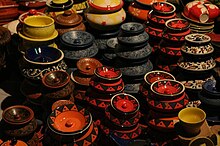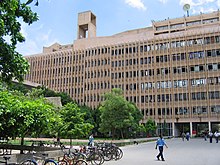Culture
See also: Culture of India

Traditional pottery on display inDilli Haat
Delhi's culture has been influenced by its lengthy history and historic association as the capital of India. This is exemplified by many significant monuments in the city. Delhi is also identified as the location ofIndraprastha, the ancient capital of thePandavas. The Archaeological Survey of India recognises 1200 heritage buildings[150] and 175 monuments as national heritage sites.[151] In the Old City, the Mughals and the Turkic rulers constructed several architecturally significant buildings, such as the Jama Masjid – India's largest mosque[152] and the Red Fort. Three World Heritage Sites – the Red Fort, Qutab Minar andHumayun's Tomb – are located in Delhi.[153] Other monuments include theIndia Gate, the Jantar Mantar – an 18th-century astronomical observatory – and the Purana Qila – a 16th-century fortress. The Laxminarayan temple,Akshardham temple, the Bahá'í Lotus temple and the ISKCON temple are examples of modern architecture. Raj Ghat and associated memorials houses memorials of Mahatma Gandhi and other notable personalities. New Delhi houses several government buildings and official residences reminiscent of British colonial architecture, including the Rashtrapati Bhavan, the Secretariat,Rajpath, the Parliament of India andVijay Chowk. Safdarjung's Tomb is an example of the Mughal gardens style. Some regal havelis (palatial residences) are in the Old City.[154]
Lotus Temple, is a Bahá'í House of Worship completed in 1986. Notable for its flowerlike shape, it serves as the Mother Temple of the Indian subcontinent and has become a prominent attraction in the city. The Lotus Temple has won numerous architectural awards and been featured in hundreds of newspaper and magazine articles. Like all other Bahá'í Houses of Worship, is open to all regardless of religion, or any other distinction, as emphasised in Bahá'í texts. The Bahá'í laws emphasise that the spirit of the House of Worship be that it is a gathering place where people of all religions may worship God without denominational restrictions.[155] The Bahá'í laws also stipulate that only the holy scriptures of the Bahá'í Faith and other religions can be read or chanted inside in any language; while readings and prayers can be set to music by choirs, no musical instruments can be played inside. Furthermore, no sermonscan be delivered, and there can be no ritualistic ceremonies practised.[155]
Festivals

Rashtrapati Bhavan been lit up forDiwali.
Delhi's association and geographic proximity to the capital, New Delhi, has amplified the importance of national events and holidays like Republic Day,Independence Day (15 August) andGandhi Jayanti. On Independence Day, the Prime Minister addresses the nation from the Red Fort. Most Delhiites celebrate the day by flying kites, which are considered a symbol of freedom.[160]The Republic Day Parade is a large cultural and military parade showcasing India's cultural diversity and military strength.[161][162] Over the centuries, Delhi has become known for its composite culture, and a festival that symbolises this is the Phool Walon Ki Sair, which takes place in September. Flowers and pankhe – fans embroidered with flowers – are offered to the shrine of 13th century Sufi saint Khwaja Bakhtiyar Kaki and the Yogmaya temple, both situated in Mehrauli.[163]
Religious festivals include Diwali (the festival of lights), Mahavir Jayanti, Guru Nanak's Birthday, Raksha Bandhan, Durga Puja, Holi, Lohri, Chauth, Krishna Janmastami, Maha Shivratri, Eid ul-Fitr,Moharram and Buddha Jayanti.[162] TheQutub Festival is a cultural event during which performances of musicians and dancers from all over India are showcased at night, with the Qutub Minar as a backdrop.[164] Other events such as Kite Flying Festival,International Mango Festival and Vasant Panchami (the Spring Festival) are held every year in Delhi. The Auto Expo, Asia's largest auto show,[165] is held in Delhi biennially. The World Book Fair, held biannually at the Pragati Maidan, is the second largest exhibition of books in the world.[166] Delhi is often regarded as the "Book Capital" of India because of high readership.[167]
Cuisine
Main article: Indian cuisine
As India's national capital and centuries old Mughal capital, Delhi influenced the food habits of its residents and is whereMughlai cuisine originated. Along with Indian cuisine, a variety of international cuisines are popular among the residents.[168] The dearth of food habits among the city's residents created a unique style of cooking which became popular throughout the world, with dishes such as Kebab, biryani, tandoori. The city's classic dishes include Butter chicken, Aloo Chaat, chaat, dahi vada,kachori, chole bhature, Chole kulche,jalebi and lassi.[168][169]:40–50, 189–196
The fast living habits of Delhi's people has motivated the growth of street foodoutlets.[169]:41 A trend of dining at localdhabas is popular among the residents. High profile restaurants have gained popularity in recent years, among the popular restaurants are the Karim Hotel, the Punjab Grill and Bukhara.[170] TheGali Paranthe Wali (the street of fried bread) is a street in Chandni Chowk particularly for food eateries since the 1870s. Almost the entire street is occupied by fast food stalls or street vendors. It has nearly become a tradition that almost every prime minister of India has visited the street to eat paratha at least once. Other Indian cuisines are also available in this area even though the street specializes in north Indian food .[169]:40–50[171]
Education
Main article: Education in Delhi

All India Institute of Medical Sciences is a global leader in medical research and treatment.[172]
Private schools in Delhi – which use either English or Hindi as the language of instruction – are affiliated to one of three administering bodies, the Council for the Indian School Certificate Examinations (CISCE), the Central Board for Secondary Education (NCERT (CBSE))[173] or the National Institute of Open Schooling (NIOS). In 2004–05, approximately 15.29 lakh (1.529 million) students were enrolled in primary schools, 8.22 lakh (0.822 million) in middle schools and 6.69 lakh (0.669 million) in secondary schools across Delhi.[174] Female students represented 49% of the total enrolment. The same year, the Delhi government spent between 1.58% and 1.95% of its gross state domestic product on education.[174]

Indian Institute of Technology, Delhi is ranked as Asia's fourth-best institute in science and technology in the year 1999.[175]
Schools and higher educational institutions in Delhi are administered either by the Directorate of Education, the NCT government or private organisations. In 2006, Delhi had 165 colleges, five medical colleges and eight engineering colleges,[174] seven major universities and nine deemed universities.[174] Indraprastha Institute of Information Technology, Delhi Technological University, Guru Gobind Singh Indraprastha University and National Law University are the onlystate universities,[176] Indira Gandhi National Open University is for distance education and the rest are central universities.[177] As of 2008, about 16% of all Delhi residents possessed at least a college graduate degree.[178]
Media

Pitampura TV Towerbroadcasts programming to Delhi
See also: Media of India
As the capital of India, Delhi is the focus of political reportage, including regular television broadcasts of Parliament sessions. Many national media agencies, including the state-ownedPress Trust of India, Media Trust of India and Doordarshan, is based in the city. Television programming includes two free terrestrial television channels offered by Doordarshan, and several Hindi, English and regional-languagecable channels offered by multi system operators. Satellite television has yet to gain a large quantity of subscribers in the city.[179]
Print journalism remains a popular news medium in Delhi. The city's Hindi newspapers include Navbharat Times,Hindustan Dainik, Punjab Kesari, Pavitra Bharat, Dainik Jagran, Dainik Bhaskar andDainik Desbandhu.[180] Amongst the English language newspapers, TheHindustan Times, with a daily circulation of over a million copies, is the single largest daily.[181] Other major English newspapers include Times of India, The Hindu, Indian Express, Business Standard,The Pioneer and The Asian Age'Top Story (Daily). Regional language newspapers include the Malayalam daily Malayala Manorama and the Tamil dailiesDinamalar and Dinakaran.[180]


No comments:
Post a Comment